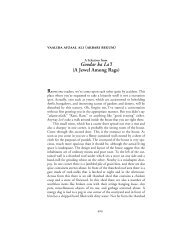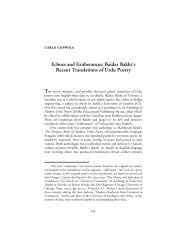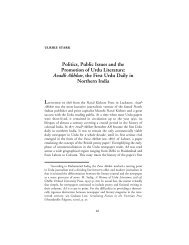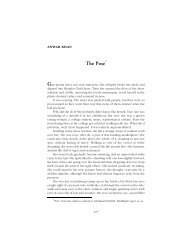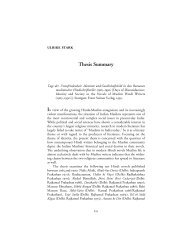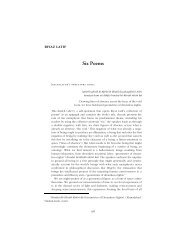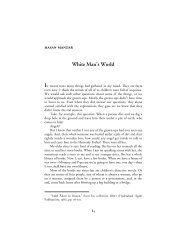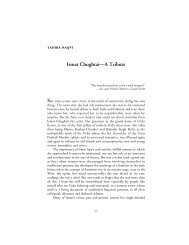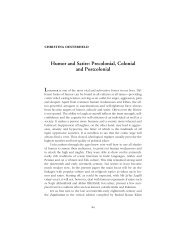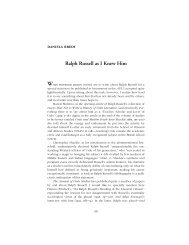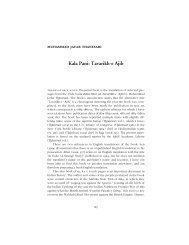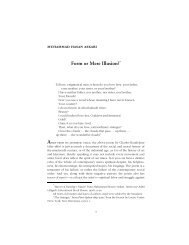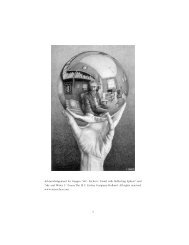Delhi College and Urdu* - MINDS@UW Home
Delhi College and Urdu* - MINDS@UW Home
Delhi College and Urdu* - MINDS@UW Home
You also want an ePaper? Increase the reach of your titles
YUMPU automatically turns print PDFs into web optimized ePapers that Google loves.
GAIL MINAULT • 127Teachers <strong>and</strong> students both participated in the work of translation, creatingtheir own textbooks in the process—an interesting blending of theoral <strong>and</strong> written traditions. Individual local benefactors helped financethe first translations <strong>and</strong> publications; then sales of texts helped the effortalong. Publications appeared from a number of local presses <strong>and</strong> eventuallyfrom the college’s own press, the Maπba‘u ’l-‘Ul∑m. The governmentalso agreed to finance the translation of math <strong>and</strong> geometry texts in orderto bring western sciences to students in the oriental section. 25The list of the society’s publications includes basic textbooks such asEuclid’s geometry (which had been a part of the Arabic as well as thewestern curriculum), <strong>and</strong> histories of Engl<strong>and</strong>, Greece, <strong>and</strong> Rome, <strong>and</strong>the geography of India. Science texts included both “natural philosophy”<strong>and</strong> y∑n≥nµ πibb (also from Arabic). Translation of oriental classics fromPersian, Arabic, <strong>and</strong> Sanskrit included Sa‘dµ’s Gulist≥n, selections fromThe Thous<strong>and</strong> <strong>and</strong> One Nights, Laila <strong>and</strong> Majnun, <strong>and</strong> the DharmaShastras. 26 The Vernacular Translation Society, therefore, made it possiblefor students of <strong>Delhi</strong> <strong>College</strong> to participate in both “the revival <strong>and</strong>improvement of literature” <strong>and</strong> “the promotion of the knowledge of thesciences,” without any apparent conflict between the two goals. Althoughthe two sections of the school remained discrete, the Orientalist-Anglicistcontroversy seemed to be much less salient in the Mughal capital citythan it did in the chambers of government in Calcutta.The study of western sciences such as astronomy <strong>and</strong> calculus was ingreat dem<strong>and</strong> among the students of the college, including those in theoriental section. <strong>Delhi</strong> <strong>College</strong> students were cognizant of the Copernicanrevolution, 27 even though most did not study English literature or west-25 MDK, pp. 127–47; Khv≥ja A√mad F≥r∑qµ, Ÿauq-o-Justaj∑ (Lucknow: Id≥raeFarågh-e Urd∑, 1967), pp. 233–91; Inti ≥r Mirz≥, “Qad≤m Delhµ K≥l®j kµ AdabµKhidam≥t k≥ J≥’iza,” Diss. <strong>Delhi</strong> University, Department of Urdu, 1984.26 MDK, pp. 148–53; Report of the GCPI, Bengal for 1840/41–1841/42, App.XV by Boutros, d. <strong>Delhi</strong>, 1 July 1842, IOLR, V/24/948.27 In fact, Newton’s Principia <strong>and</strong> other works of European mathematics <strong>and</strong>astronomy that supported the heliocentric view of the universe had already beentranslated into Arabic <strong>and</strong> Persian in India in the late eighteenth century byMaulvµ Tafa¤¤ul ƒusain Kh≥n of Lucknow. He is mentioned in the Asiatick AnnualRegister of 1803, pp. 1–8; <strong>and</strong> in Ab∑ ∫≥lib Kh≥n, Ma’¡ir-e ∫≥libµ (personalcommunication between the author <strong>and</strong> M. Tavakoli-Targhi). Cf. Tavakoli-Targhi, “Orientalism’s Genesis Amnesia;” <strong>and</strong> C.A. Bayly, “Colonial Star Wars:



